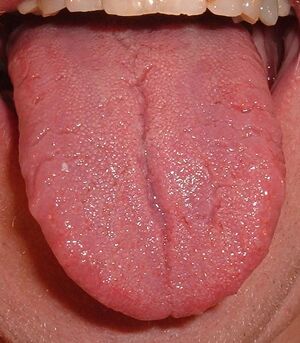Tongue
The tongue is a strong muscle anchored to the floor of the mouth. It is covered by the lingual membrane which has special areas to detect tastes.
The tongue is composed of muscles attached to the lower jaw and to the hyoid bone (a small, U-shaped bone that lies deep in the muscles at the back of the tongue) above the larynx.
On the top surface of the tongue there are small nodules called papillae that give the tongue its rough texture. Between the papillae at the sides and base of the tongue, there are small bulb-like structures that are the taste buds. The muscle fibers of the tongue are heavily supplied with nerves.
Babies have more taste buds than adults and they have these almost everywhere in the mouth, including the cheeks.
The tongue is made mainly of skeletal muscle and attached to the hyoid bone, mandible and the styloid processes of the temporal bone.
The muscles that attach the tongue are the extrinsic muscles of the tongue. Inside the tongue, there are four pairs of intrinsic muscles that can alter the shape of the tongue for talking and swallowing. Since it contains no supporting skeletal structures for the muscles, the tongue is an example of a muscular hydrostat, like an octopus arm.
The dorsum (top side) of the tongue can be divided into two parts, a pharyngeal part (posterior third of the tongue), which faces backward to the oropharynx, and an oral part (anterior two-thirds of the tongue) that lies mostly in the mouth. The two parts are separated by a V-shaped groove, which marks the sulcus terminalis (or terminal sulcus).
